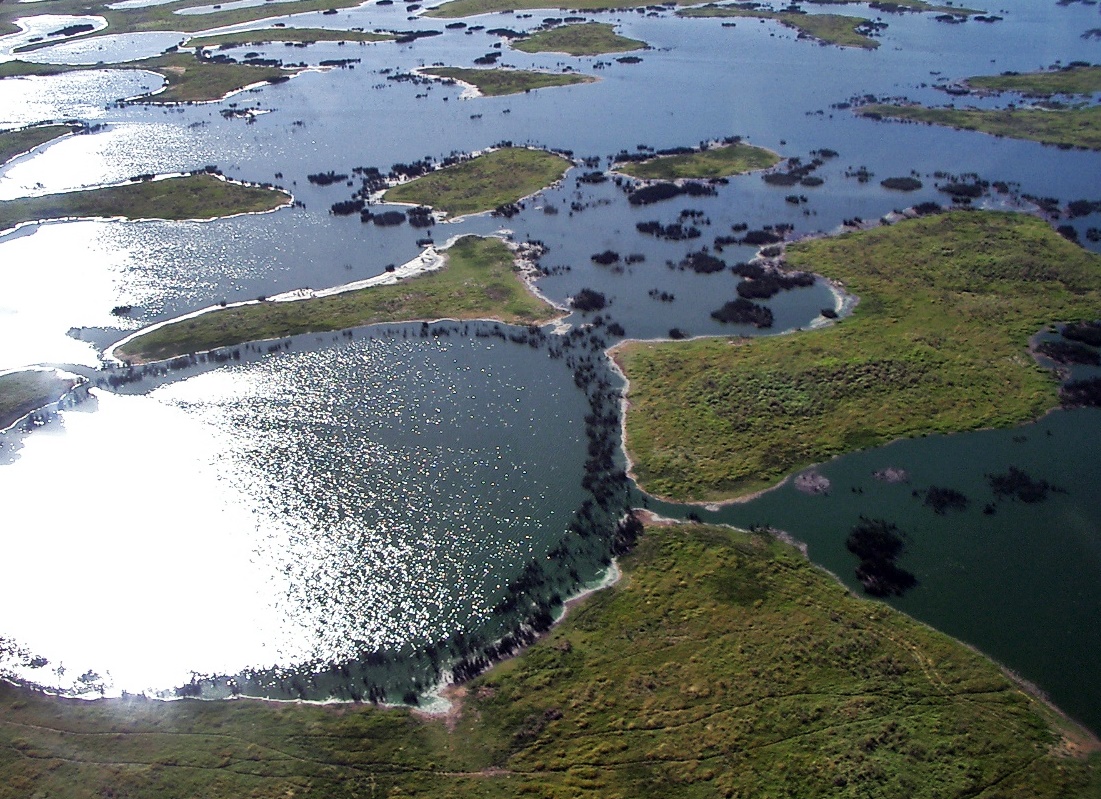Flooded Grasslands on:
[Wikipedia]
[Google]
[Amazon]

 Flooded grasslands and savannas is a terrestrial
Flooded grasslands and savannas is a terrestrial

biome
A biome () is a biogeographical unit consisting of a biological community that has formed in response to the physical environment in which they are found and a shared regional climate. Biomes may span more than one continent. Biome is a broader ...
of the WWF biogeographical system, consisting of large expanses or complexes of flooded grassland
A grassland is an area where the vegetation is dominated by grasses (Poaceae). However, sedge (Cyperaceae) and rush (Juncaceae) can also be found along with variable proportions of legumes, like clover, and other herbs. Grasslands occur natur ...
s. These areas support numerous plants and animals adapted to the unique hydrologic regimes and soil conditions. Large congregations of migratory and resident waterbird
A water bird, alternatively waterbird or aquatic bird, is a bird that lives on or around water. In some definitions, the term ''water bird'' is especially applied to birds in freshwater ecosystems, although others make no distinction from seabi ...
s may be found in these regions. However, the relative importance of these habitat types for these birds as well as more vagile taxa typically varies as the availability of water and productivity
Productivity is the efficiency of production of goods or services expressed by some measure. Measurements of productivity are often expressed as a ratio of an aggregate output to a single input or an aggregate input used in a production proces ...
annually and seasonally shifts among complexes of smaller and larger wetlands throughout a region.
This habitat type is found on four of the continents on Earth. Some globally outstanding flooded savannas and grasslands occur in the Everglades
The Everglades is a natural region of tropical climate, tropical wetlands in the southern portion of the U.S. state of Florida, comprising the southern half of a large drainage basin within the Neotropical realm. The system begins near Orland ...
, Pantanal, Lake Chad flooded savanna
The Lake Chad flooded savanna is a flooded grasslands and savannas ecoregion in Africa. It includes the seasonally- and permanently-flooded grasslands and savannas in the basin of Lake Chad in Central Africa, and covers portions of Cameroon, Ch ...
, Zambezian flooded grasslands
The Zambezian flooded grasslands is an ecoregion of southern and eastern Africa that is rich in wildlife.
Setting
The Zambezian flooded grasslands can be found on seasonally- or permanently-flooded lowlands in the basin of the Zambezi and neighbo ...
, and the Sudd
The Sudd (' or ', Dinka language, Dinka: Toc) is a vast swamp in South Sudan, formed by the White Nile's ''Mountain Nile, Baḥr al-Jabal'' section. The Arabic language, Arabic word ' is derived from ' (), meaning "barrier" or "obstruction". The ...
. The Everglades, with an area of , are the world's largest rain-fed flooded grassland on a limestone
Limestone ( calcium carbonate ) is a type of carbonate sedimentary rock which is the main source of the material lime. It is composed mostly of the minerals calcite and aragonite, which are different crystal forms of . Limestone forms whe ...
substrate, and feature some 11,000 species of seed-bearing plants, 25 varieties of orchids, 300 bird species, and 150 fish species. The Pantanal, with an area of , is the largest flooded grassland on Earth, supporting over 260 species of fish, 700 birds, 90 mammals, 160 reptiles, 45 amphibians, 1,000 butterflies, and 1,600 species of plants. The flooded savannas and grasslands are generally the largest complexes in each region.
See also
*Coniferous swamp
Coniferous swamps are forested wetlands in which the dominant trees are lowland conifers such as northern white cedar (''Thuja occidentalis''). The soil in these swamp areas is typically saturated for most of the growing season and is occasional ...
* Dambo
* Fen
A fen is a type of peat-accumulating wetland fed by mineral-rich ground or surface water. It is one of the main types of wetlands along with marshes, swamps, and bogs. Bogs and fens, both peat-forming ecosystems, are also known as mires. T ...
* Flood-meadow
* Freshwater swamp forest
* Mangroves
* Marsh
A marsh is a wetland that is dominated by herbaceous rather than woody plant species.Keddy, P.A. 2010. Wetland Ecology: Principles and Conservation (2nd edition). Cambridge University Press, Cambridge, UK. 497 p Marshes can often be found at ...
* Marsh gas
* Muck (soil)
* Peat
Peat (), also known as turf (), is an accumulation of partially decayed vegetation or organic matter. It is unique to natural areas called peatlands, bogs, mires, moors, or muskegs. The peatland ecosystem covers and is the most efficien ...
* Peat swamp forest
* Salt marsh
A salt marsh or saltmarsh, also known as a coastal salt marsh or a tidal marsh, is a coastal ecosystem in the upper coastal intertidal zone between land and open saltwater or brackish water that is regularly flooded by the tides. It is dominated ...
* Shrub swamp
Shrub swamps — also called scrub swamps or buttonbush swamps — are a type of freshwater wetland ecosystem occurring in areas too wet to become swamps (“true” or freshwater swamp forest), but too dry or too shallow to become marshes. They ...
* Water-meadow
A water-meadow (also water meadow or watermeadow) is an area of grassland subject to controlled irrigation to increase agricultural productivity. Water-meadows were mainly used in Europe from the 16th to the early 20th centuries. Working water-m ...
* Wet meadow
References
Grasslands Wetlands Terrestrial biomes {{Ecology-stub